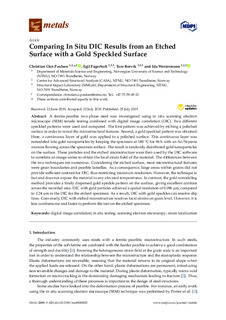| dc.contributor.author | Paulsen, Christian Oen | |
| dc.contributor.author | Fagerholt, Egil | |
| dc.contributor.author | Børvik, Tore | |
| dc.contributor.author | Westermann, Ida | |
| dc.date.accessioned | 2019-08-09T10:37:44Z | |
| dc.date.available | 2019-08-09T10:37:44Z | |
| dc.date.created | 2019-07-29T13:21:19Z | |
| dc.date.issued | 2019 | |
| dc.identifier.citation | Metals. 2019, 9 (820), . | nb_NO |
| dc.identifier.issn | 2075-4701 | |
| dc.identifier.uri | http://hdl.handle.net/11250/2607749 | |
| dc.description.abstract | A ferrite-pearlite two-phase steel was investigated using in situ scanning electron microscope (SEM) tensile testing combined with digital image correlation (DIC). Two different speckled patterns were used and compared. The first pattern was achieved by etching a polished surface in order to reveal the microstructural features. Second, a gold speckled pattern was obtained. Here, a continuous layer of gold was applied to a polished surface. This continuous layer was remodeled into gold nanoparticles by keeping the specimen at 180 °C for 96 h with an Ar/Styrene mixture flowing across the specimen surface. The result is randomly distributed gold nanoparticles on the surface. These particles and the etched microstructure were then used by the DIC software to correlate an image series to obtain the local strain field of the material. The differences between the two techniques are numerous. Considering the etched surface, most microstructural features were grain boundaries and pearlite lamellas. As a consequence, large areas within grains did not provide sufficient contrast for DIC, thus restricting maximum resolution. However, the technique is fast and does not expose the material to any elevated temperatures. In contrast, the gold remodeling method provides a finely dispersed gold speckle pattern on the surface, giving excellent contrast across the recorded area. DIC with gold particles achieved a spatial resolution of 0.096 µm, compared to 2.24 µm in the DIC for the etched specimen. As a result, DIC with gold speckles can resolve slip lines. Conversely, DIC with etched microstructure resolves local strains on grain level. However, it is less cumbersome and faster to perform the test on the etched specimen. | nb_NO |
| dc.language.iso | eng | nb_NO |
| dc.publisher | MDPI | nb_NO |
| dc.rights | Navngivelse 4.0 Internasjonal | * |
| dc.rights.uri | http://creativecommons.org/licenses/by/4.0/deed.no | * |
| dc.title | Comparing In Situ DIC Results from an Etched Surface with a Gold Speckled Surface | nb_NO |
| dc.type | Journal article | nb_NO |
| dc.type | Peer reviewed | nb_NO |
| dc.description.version | publishedVersion | nb_NO |
| dc.source.pagenumber | 23 | nb_NO |
| dc.source.volume | 9 | nb_NO |
| dc.source.journal | Metals | nb_NO |
| dc.source.issue | 820 | nb_NO |
| dc.identifier.doi | 10.3390/met9080820 | |
| dc.identifier.cristin | 1713058 | |
| dc.description.localcode | © 2019 by the authors. Licensee MDPI, Basel, Switzerland. This article is an open access article distributed under the terms and conditions of the Creative Commons Attribution (CC BY) license (http://creativecommons.org/licenses/by/4.0/). | nb_NO |
| cristin.unitcode | 194,66,35,0 | |
| cristin.unitcode | 194,64,45,0 | |
| cristin.unitname | Institutt for materialteknologi | |
| cristin.unitname | Institutt for konstruksjonsteknikk | |
| cristin.ispublished | true | |
| cristin.fulltext | original | |
| cristin.qualitycode | 1 | |

